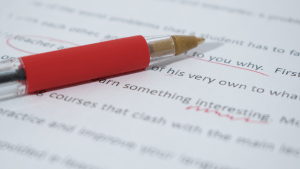If you have ever compared titles throughout several different articles, you may be wondering why there are differences in styles and most importantly, which one is correct. After all, we want our work to look and feel professional. You will find that there are several different formats you can choose from when constructing your title, such as sentence case, title case, and uppercase, to name a few. Below, I have dissected some of the most popular methods into digestible points.
What is sentence case?
You will find this is used by a lot of print and online publications. There are only two pretty simple rules:
- Capitalise the first letter
- Capitalise proper nouns
And the rest of the title is in lowercase. See the example below.
‘An introduction to writing’
As you can see, ‘An’ has an uppercase letter while the rest is in lowercase.
What is Title Case?
This is another method of writing a title. It is most commonly used for book titles and headlines, among other things. Below I have set out the basic rules you should follow:
- Always capitalise the first and last word in the sentence
- Capitalize the important words
- Adjectives (tiny, large, etc.)
- Adverbs
- Nouns
- Pronouns
- Subordinating conjunctions
- Verbs
See the example below:
‘An Introduction to Writing’
Keep in mind that some words are not capitalised in ‘Title Case’ which are generally short words (also known as stop words) and conjunctions.
A common misunderstanding of the title method is that all short words are written in lowercase. In many cases this would be correct, however, something to keep in mind is that short words can be nouns, pronouns, and verbs which should have a capital letter.
The lazy method
Again, you will see this method used fairly often, although probably not as much as the previous two. We like to call it the lazy method as it requires little to no effort; you simply capitalise every word in the title.
For example:
‘An Introduction To Writing’
Other methods
There are a couple of other methods that you see occasionally that I like to avoid. Lower case titles tend to give the impression that the article lacks importance:
‘an introduction to writing’
And over-capitalisation can give the reader the wrong impression. Some readers actually see it as the equivalent of shouting, which can be misinterpreted as rudeness. Not a good start to an article!
See the example below:
‘AN INTRODUCTION TO WRITING’
Doesn’t that just make you feel uncomfortable?
I’m still unsure of how to write my title
Don’t worry, many people stick to personal preference and consistently run with it throughout their articles, which is fine, there is no rule to say you can’t. However, there are various organisations you can look to for guidance. They have developed their style guides which are now widely followed throughout the writing community.
Common styles created by organisations
You will find that there are four main styles of title capitalisation:
- Chicago style
- APA style
- MLA style
- AP style
Each of these has its own rules which differ slightly from one to another. By following one of these styles, it will help you to remain consistent both in your work as well as keeping in line with traditional styles. There are plenty of websites that provide more in-depth information about these styles online. You will see that different styles will use different methods, for instance, one will use sentence case, while another uses the title case.
Final words of advice…
If you are striving for sexy headlines that are aesthetically pleasing, then you must have a good grasp on when and what to capitalise in your title. By following the general rules that have been set out above, you will be able to work out what rule suits you and your style of writing. Just remember to be consistent. If you are still uncertain about which words should be capitalised, this tool is a great one to check out! And when you’re all done with titles, check out our blog on commas… another tricky one to master!!
Good luck and have fun!





